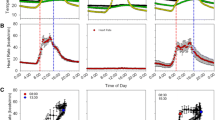Abstract.
Eastern grey kangaroos (Macropus giganteus) are generally regarded as mesic inhabitants. Even though access to drinking water in permanent stock watering troughs is commonly available, these animals are still found in only low densities in arid pastoral areas. We hypothesised that the differential success of red and grey kangaroos in the arid zone may be due to higher energy requirements of M. giganteus with a concomitant need for increased food, rather than limitations imposed by inadequate water access. We set out to test this by indirectly measuring energy expenditure through the monitoring of heart rate by radio telemetry in semi-free-ranging eastern grey and red kangaroos (Macropus rufus). Radio telemetry measurements of heart rate were calibrated against oxygen consumption and were used in the assessment of energy expenditure of animals maintained in an 8-ha enclosure in the arid zone of southeast Australia. Heart rate provided a reliable estimate of oxygen consumption. This well-correlated relationship was curvilinear and was established for each individual. Behavioural observations revealed that both kangaroo species spent most of the day in low energy demanding activities. M. rufus were more active at night whilst M. giganteus were more active in the early mornings and late afternoons. Like other marsupials, both species had low field metabolic rates (FMRs). However, M. giganteus in keeping with their mesic history had higher FMRs than the more arid-adapted M. rufus, particularly during water restriction. Body temperature telemeters revealed a further species difference in that under hot conditions when water is freely available, M. rufus exhibits a higher and more labile daytime body temperature than M. giganteus. During the hottest part of the day M. giganteus maintain body temperature, relying upon increased evaporative cooling mechanisms, such as licking. Indeed, only when access to drinking water was restricted was thermolability evident in M. giganteus. Differences in behaviour and concomitant energy expenditure may thus contribute substantially to the divergent distribution and abundance of these two kangaroo species.
Similar content being viewed by others
Author information
Authors and Affiliations
Additional information
Electronic Publication
Rights and permissions
About this article
Cite this article
McCarron, .H., Buffenstein, .R., Fanning, .F. et al. Free-ranging heart rate, body temperature and energy metabolism in eastern grey kangaroos (Macropus giganteus) and red kangaroos (Macropus rufus) in the arid regions of South East Australia. J Comp Physiol B 171, 401–411 (2001). https://doi.org/10.1007/s003600100189
Accepted:
Issue Date:
DOI: https://doi.org/10.1007/s003600100189




